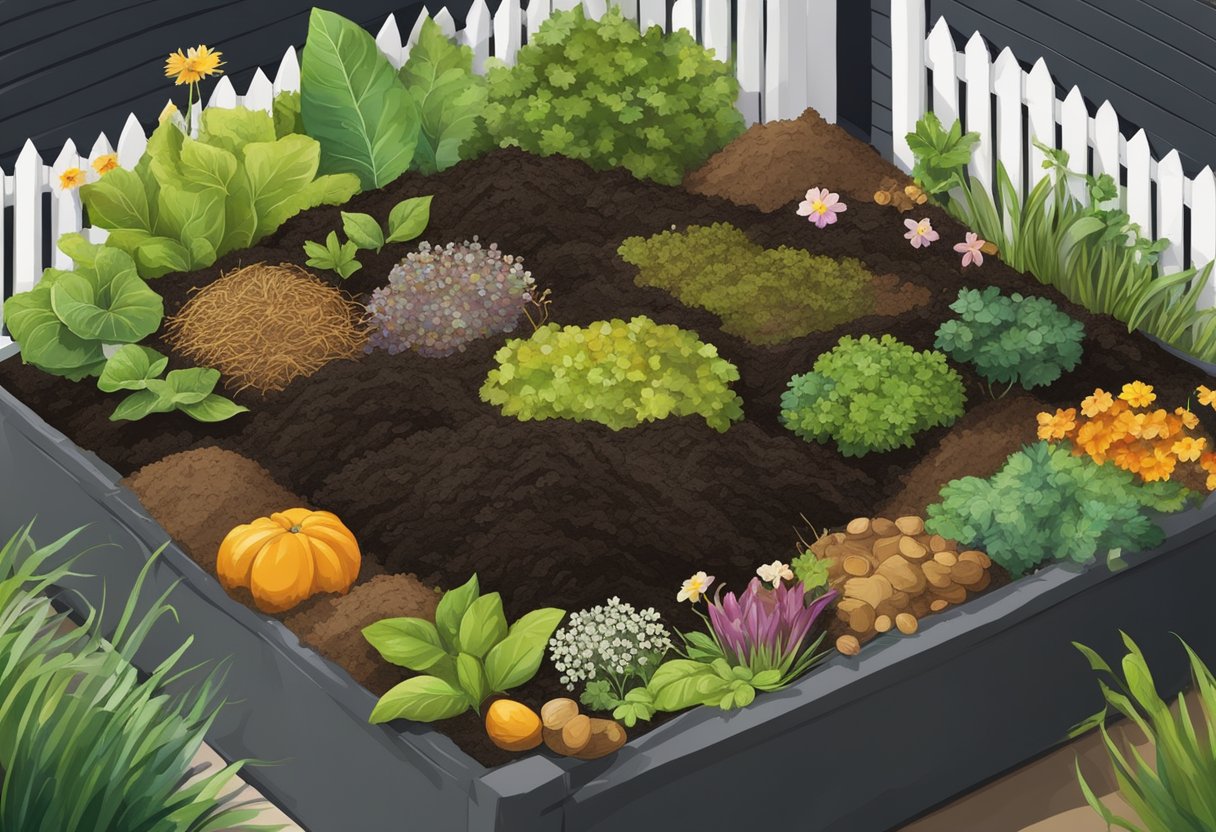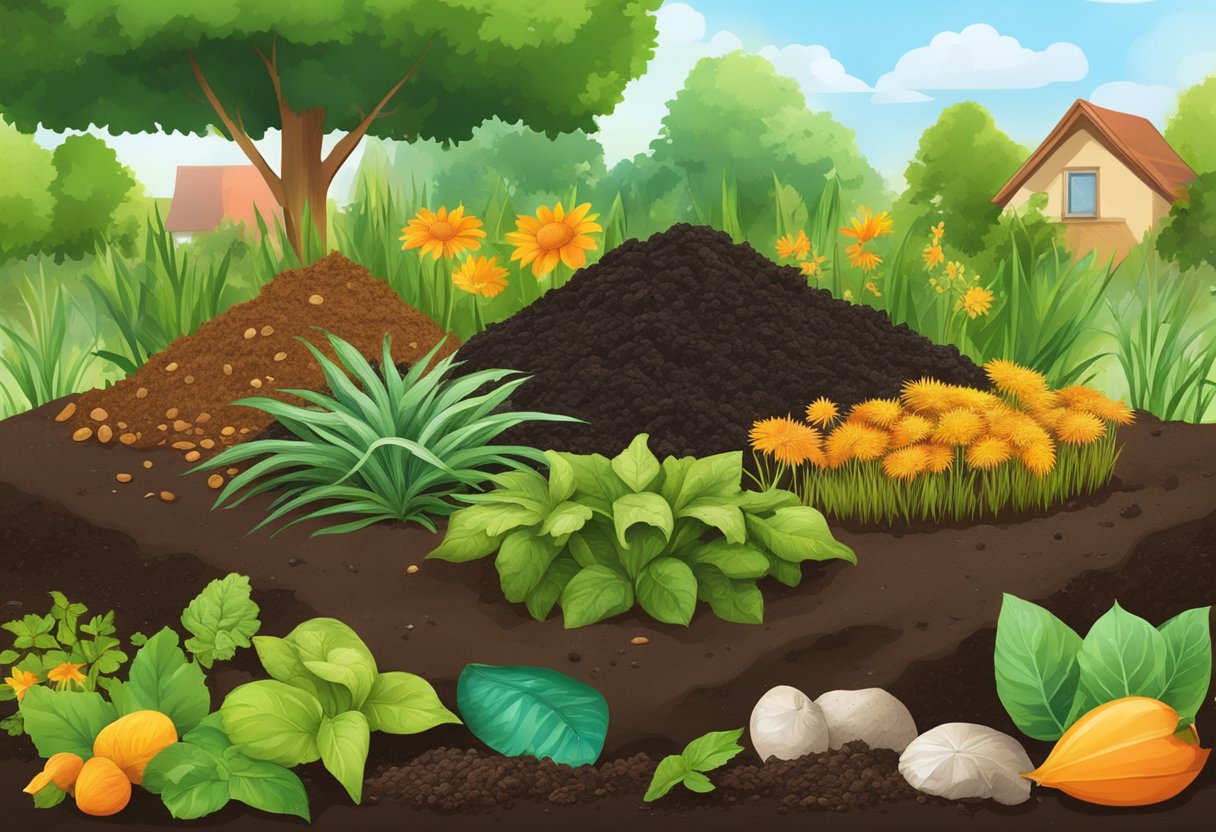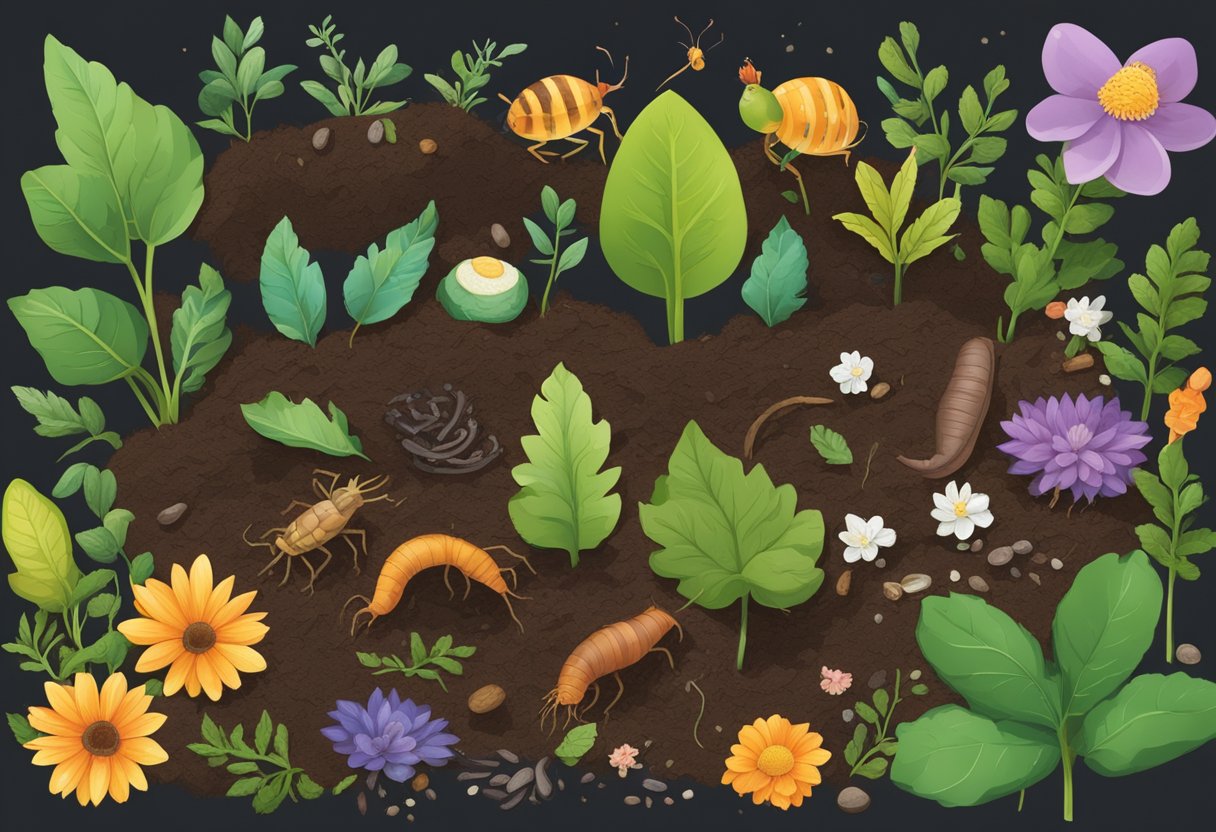As an Amazon Associate I earn from qualifying purchases.
At A Glance
The best type of compost for flower beds is well-rotted organic compost which is rich in nutrients and organic matter. It should be dark, crumbly, and earthy-smelling, indicating its readiness for use. Composts made from a variety of materials such as leaves, fruit and vegetable scraps, and non-seeded garden waste provide a balanced nutrient profile that promotes healthy flower growth and blooms. Additionally, compost that has been screened for large particles will have a fine texture, which is ideal for flower beds. Some gardeners also consider vermicompost, made from worm castings, to be highly beneficial for flower beds due to its nutrient richness and microbial activity.
When it comes to creating a beautiful and healthy flower bed, one of the most important factors is the type of compost you use. Compost is a nutrient-rich soil amendment that can improve the quality of your soil, helping your plants grow stronger and more vibrant. But with so many different types of compost available, it can be difficult to know which one is the best choice for your flower beds.

In general, the best type of compost for flower beds is one that is rich in organic matter and nutrients. Homemade aged compost, vermicompost, aged manures, and mushroom compost are all great options for your flower beds. These types of compost are typically high in nitrogen, phosphorus, and potassium, which are essential nutrients for plant growth. Additionally, they can help to improve soil structure, promote healthy root growth, and increase water retention in the soil.
However, it’s important to note that not all compost is created equal. Some types of compost may contain weed seeds, pathogens, or other contaminants that can harm your plants. Therefore, it’s important to choose high-quality compost from a reputable source. You may also want to consider testing your soil to determine which nutrients are lacking, so that you can choose a compost that will address those deficiencies. With the right type of compost, you can create a healthy and vibrant flower bed that will thrive for years to come.
Types of Compost

When it comes to choosing the right compost for your flower beds, you have several options to consider. In this section, I will discuss three common types of compost: bagged compost, homemade compost, and vermicompost.
Bagged Compost
Bagged compost is a convenient option for those who don’t have time or space to make their own compost. It is readily available at most garden centers and home improvement stores. Bagged compost is typically made from a blend of organic materials, such as food waste, plant material, and manure. Some bagged composts are also enriched with additional nutrients, such as bone meal or blood meal.
When choosing a bagged compost, look for one that is labeled as “organic” and has been certified by the Organic Materials Review Institute (OMRI). This ensures that the compost is free from synthetic chemicals and has been produced using sustainable methods.
Homemade Compost
Making your own compost is a great way to reduce waste and create a nutrient-rich soil amendment for your flower beds. Homemade compost can be made using a variety of organic materials, such as kitchen scraps, yard waste, and shredded paper.
To make your own compost, start by choosing a compost bin or creating a compost pile in a sunny spot in your yard. Add a mixture of “brown” materials, such as leaves or shredded paper, and “green” materials, such as kitchen scraps or grass clippings. Turn the compost regularly to ensure that it decomposes evenly and doesn’t become too compact.
Vermicompost
Vermicompost, also known as worm castings, is a type of compost that is produced by earthworms. Vermicompost is highly nutritious and contains beneficial microorganisms that help improve soil health.
To make vermicompost, start by setting up a worm bin in a cool, shady spot in your yard. Add a layer of bedding material, such as shredded newspaper or coconut coir, and then add your worms. Feed your worms a mixture of kitchen scraps and yard waste, and they will produce nutrient-rich vermicompost for your flower beds.
In conclusion, choosing the right compost for your flower beds can help improve soil health and promote healthy plant growth. Whether you choose bagged compost, homemade compost, or vermicompost, be sure to choose a high-quality, organic product that is free from synthetic chemicals.
Compost Ingredients
As a gardener, I know that compost is an essential ingredient for healthy and thriving flower beds. Compost is rich in nutrients and helps to improve soil structure, making it easier for roots to grow and absorb nutrients. In this section, I will discuss some of the most common compost ingredients and their benefits.
Organic Matter
Organic matter is an essential ingredient in any compost pile. It includes things like vegetable and fruit scraps, coffee grounds, and eggshells. Organic matter is rich in nitrogen and other essential nutrients that plants need to grow. It also helps to improve soil structure and water retention.
Manure
Manure is a great source of nitrogen and other essential nutrients. It can be used to improve soil fertility and structure. However, it’s important to use well-aged manure to avoid burning plants with high nitrogen content. Additionally, it’s important to know the source of the manure to avoid introducing harmful pathogens to your garden.
Leaves and Grass Clippings
Leaves and grass clippings are excellent sources of carbon for your compost pile. They help to balance out the high nitrogen content of other ingredients like kitchen scraps and manure. Additionally, they are readily available and free in most cases. However, it’s important to shred leaves and grass clippings before adding them to your compost pile to speed up the decomposition process.
Wood Chips
Wood chips are another source of carbon for your compost pile. They are slow to decompose, but they help to improve soil structure and water retention. Additionally, they can help to balance out the high nitrogen content of other ingredients like manure. However, it’s important to avoid using treated wood chips, as they can contain harmful chemicals that can be harmful to plants.
Overall, the best compost for flower beds is one that contains a balance of organic matter, manure, leaves, grass clippings, and wood chips. By using a variety of ingredients, you can ensure that your plants have access to all the nutrients they need to grow and thrive.
Nutrient Content of Compost

Compost is a valuable soil amendment for flower beds because it provides essential nutrients that plants need to thrive. These nutrients include nitrogen, phosphorus, and potassium, which are often referred to as NPK.
Nitrogen
Nitrogen is a critical nutrient for plant growth and is necessary for the development of healthy foliage. Compost that is high in nitrogen is ideal for plants that require a lot of foliage, such as leafy greens and herbs. Some examples of compost that are high in nitrogen include cottonseed meal and alfalfa meal.
Phosphorus
Phosphorus is essential for root development, flowering, and fruiting. Compost that is high in phosphorus is ideal for plants that require a lot of energy to produce flowers and fruit, such as tomatoes and peppers.
Potassium
Potassium is important for overall plant health and helps plants resist disease and stress. Potassium-rich compost is ideal for flower production and can help plants produce bigger, brighter blooms.
When choosing a compost for flower beds, it’s important to consider the nutrient content and balance. Opting for organic compost is recommended as it is derived from natural sources, free from harmful chemicals and synthetic additives. Organic compost promotes long-term soil health and sustainability.
In summary, compost is a valuable source of nutrients for flower beds, providing essential NPK nutrients that plants need to thrive. When choosing a compost, it’s important to consider the nutrient content and balance, and opt for organic compost for long-term soil health and sustainability.
Benefits of Compost for Flower Beds
Compost is an essential component of any healthy garden. It is the result of decomposed organic matter such as leaves, grass clippings, and kitchen scraps. Adding compost to your flower beds can provide numerous benefits for your plants and overall soil health.
Soil Structure
One of the primary benefits of adding compost to flower beds is improved soil structure. Compost can help loosen compacted soil, allowing roots to penetrate more easily. This improved soil structure also promotes better drainage and aeration, which is essential for healthy plant growth.
Water Retention
Compost can also help retain water in the soil, which is crucial for flower beds. The organic matter in compost helps to increase the soil’s water-holding capacity, reducing the need for frequent watering. This is especially important during hot and dry periods when water can quickly evaporate from the soil.
Disease Resistance
Adding compost to your flower beds can also help prevent diseases. Compost contains beneficial microorganisms that can help suppress harmful pathogens in the soil. This can help reduce the risk of diseases that can harm your plants, such as root rot or damping-off.
In conclusion, adding compost to your flower beds can provide numerous benefits for your plants and overall soil health. It can improve soil structure, retain water, and promote disease resistance. By incorporating compost into your gardening routine, you can create a healthy and thriving garden.
Choosing the Right Compost for Your Flower Beds
When it comes to choosing the right compost for your flower beds, there are a few factors to consider. In this section, I will discuss the soil type and flower type considerations to help you make an informed decision.
Consider the Soil Type
The type of soil you have in your flower bed is an important factor to consider when choosing the right compost. If you have clay soil, you will want to choose a compost that is high in organic matter and will help improve soil structure. On the other hand, if you have sandy soil, you will want to choose a compost that is rich in nutrients and will help retain moisture.
Another important factor to consider is the pH of your soil. If your soil is too acidic, you can add lime to raise the pH. If it is too alkaline, you can add sulfur to lower the pH. Choosing a compost that is appropriate for your soil pH will help ensure that your flowers grow healthy and strong.
Consider the Types of Flowers
Different types of flowers have different nutrient requirements. For example, roses require a lot of nitrogen to grow healthy and produce beautiful blooms. Annuals, on the other hand, require a balanced fertilizer that is high in phosphorus to promote flower production.
When choosing the right compost for your flower bed, it is important to consider the nutrient requirements of the flowers you plan to grow. Look for a compost that is high in the nutrients your flowers need, such as nitrogen, phosphorus, and potassium.
In addition to nutrient content, soil texture is also an important factor to consider. A compost that is too fine can lead to poor drainage, while a compost that is too coarse can lead to poor water retention. Look for a compost that has a balanced texture and will help improve soil structure.
By considering factors such as soil type, flower type, and nutrient content, you can choose the right compost for your flower beds and help ensure that your flowers grow healthy and strong.
Application of Compost in Flower Beds
As a gardener, I know that compost is an essential ingredient for a healthy flower bed. There are several ways to apply compost to your flower beds, including top dressing, mulching, and using compost tea.
Top Dressing
Top dressing is a simple and effective way to apply compost to your flower beds. Simply spread a layer of compost over the surface of the soil around your plants. This can be done in early spring, before the growing season begins, or in the fall, after the plants have died back.
Top dressing with compost can help to improve the soil structure, increase water retention, and provide essential nutrients to your plants. It can also help to suppress weeds and reduce soil erosion.
Mulching
Mulching is another great way to apply compost to your flower beds. Simply spread a layer of compost over the surface of the soil around your plants, and then cover it with a layer of organic mulch, such as straw or shredded leaves.
Mulching with compost can help to improve the soil structure, increase water retention, and provide essential nutrients to your plants. It can also help to suppress weeds, reduce soil erosion, and regulate soil temperature.
Compost Tea
Compost tea is a liquid fertilizer made from compost, water, and other additives, such as molasses or seaweed extract. To make compost tea, simply steep a bag of compost in water for several days, then strain out the solids and apply the liquid to your flower beds.
Compost tea can help to improve soil health, increase plant growth, and suppress diseases and pests. It can also be used as a foliar spray, which can help to improve plant health and reduce the need for chemical pesticides.
When it comes to choosing the best compost for flower beds, I recommend using a nutrient-rich compost that is well-aged and free of weed seeds. Mushroom compost, homemade aged compost, vermicompost, and aged manures are all great options to consider.
Overall, applying compost to your flower beds is a simple and effective way to improve soil health, increase plant growth, and reduce the need for chemical fertilizers and pesticides.
Composting for Specific Plants
Composting is an excellent way to add nutrients to the soil in your flower beds. However, not all plants require the same type of compost. Here are some guidelines for composting specific plants.
Vegetables
Vegetables require a lot of nutrients to grow, so it is essential to use a high-quality compost. Compost that contains a mix of animal manure and vegetable waste is ideal. This type of compost is rich in nitrogen, phosphorus, and potassium, which are essential nutrients for vegetable plants. You can also add coffee grounds to the compost to increase the nitrogen content.
Trees and Shrubs
Trees and shrubs require a different type of compost than vegetables. They need a compost that is high in organic matter and has a neutral pH. Compost that is made from shredded leaves and wood chips is ideal for trees and shrubs. This type of compost is rich in organic matter, which helps to improve soil structure and water retention.
Fruit
Fruit trees and bushes require a lot of nutrients to produce a good crop. Compost that is rich in potassium is ideal for fruit plants. You can make your own potassium-rich compost by adding banana peels and other fruit waste to your compost pile. You can also use a commercial compost that is specifically designed for fruit plants.
When composting for specific plants, it is important to keep in mind the needs of the plants. Adding the right type of compost will help to ensure healthy growth and a good harvest. Additionally, composting is an excellent way to attract bees and butterflies to your vegetable and fruit gardens. These pollinators are essential for a successful harvest.
Conclusion
In conclusion, choosing the right type of compost for flower beds is crucial for the health and growth of your plants. Homemade aged compost, vermicompost, aged manures, and mushroom compost are all great options for your flower beds.
When selecting the best compost for your flower beds, consider the nutrient content and balance, texture and particle size, and the specific needs of your flowers. Look for compost that offers a balanced blend of essential nutrients such as nitrogen, phosphorus, and potassium (NPK).
Texture and particle size are also important factors to consider when selecting compost for your flower beds. Compost should have a crumbly texture that easily integrates with the soil.
Furthermore, it is important to ensure that the compost you choose aligns with the specific needs of your flowers. For example, potassium-rich compost is ideal for flower production.
Overall, the best compost for any situation is the one that rectifies a deficiency in the soil and improves the soil’s structure by adding organic material, encouraging soil biota, improving water retention, stability, and a slow release of nutrients. With the right type of compost, you can ensure your flower beds thrive and produce beautiful blooms.
